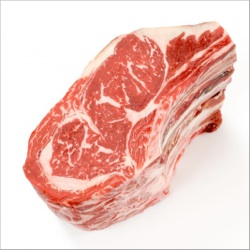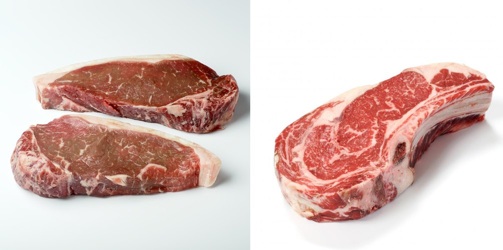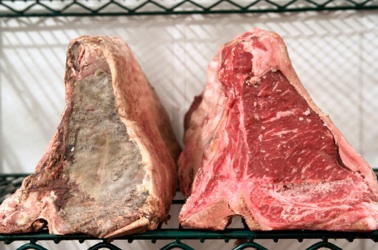Bryan’s Fine Foods, Bryan Flannery, Beef, Meat, Steak, Butcher, Prime, Choice, Burgers, Hamburger, Recommendations, Steak, Knives, Butcher Tools, San Francisco, CA, California, Burgers, Best burger in San Francisco, St. Helena, Napa, Where to eat, Where to shop, Butcher, Steak Tips, Burger Tips, How To Buy, Beef Tips, How To Cook A Steak, Cuts of Beef, Best Cuts of Beef, How To Buy Beef




Seasoning & Marinading Different Cuts
I won’t marinate the better cuts, because they will bring a flavor profile with them. The rib-eye and the New York Strip have a flavor; the filet’s a little weaker. For these, I season with salt and pepper at the beginning. I use a traditional kosher salt or a sea salt and fresh ground pepper. I make a 10:1 salt and pepper blend and just sprinkle it all over the steak.
When I’m looking to marinate something, I’ll drop to a flank steak or a tri-tip or one of the lesser cuts. Sometimes, I’ll marinate skirt steaks.
We’ve made a couple of marinades for the tri-tip that were really good. It’s basically an blend of 15 to 20 dried herbs, then we blended in shoyu (soy sauce). It gives it a really black look. The interesting thing is that it keeps the rub on the steak, much better than a dry rub stays on the steak.
Prepping
With beef, you want it to be room temperature before you start cooking it. By the time the steak is ready to be flipped, the top side is much hotter than room temperature. The goal is to simply get the heat to the middle of the meat, so the second side doesn’t need as much time as the front side.
I don’t use any oil on the meat -- I will on fish.
Grilling
There’s one tip that’s magic on the grill and this works with everything (fish, chicken, steak, etc.). I used to cook everything half and half, i.e. half the time on one side and half the time on the second side. Now I cook two thirds on one side and one third on the second side. I learned this from some chefs in San Francisco who were only cooking fish on one side.
In The Kitchen
The concept I use is the same in the kitchen as I would outside. If I am going to cook a steak in the kitchen, I would probably sear it in a skillet and finish it in a 350 degree F oven. I like the marking and the darkness on the outside, but I don’t like a heavy crust. If you cook it all the way in the pan, you are going to get a crust.
Take a steak that is 1 1/4 inch to 1 1/2 inch thick, give it a two to three minute sear on each side in a good hot pan, then move it into a pre-heated 350 degree F oven for 15 minutes and it’s a home run.
Let It Rest
For a regular steak, by the time you get it from the grill to the table and the rest of the meal is ready, that’s plenty of time to rest it -- so no more than 5 minutes. For a roast, you can let it rest for 15 minutes.
You also have to remember, when you take it off the grill, it’s going to continue cooking a little bit.
Who
Butcher Bryan Flannery is the owner of Bryan’s Fine Foods.
Why
Bryan is a second-generation butcher who has built a reputation as one of the country’s best for his meticulous sourcing and high caliber products.
Butcher Bryan Flannery | Bryan’s Fine Foods
March 23, 2012








Meat Tips & Recs









March 23, 2012
Photographs courtesy of Bryan’s Fine Foods
Recommended By
- Wine Importer Jose Pastor


I’m second-generation in this business and Bryan’s Foods is coming up on 50 years. My dad used to actually go to the slaughter houses in the days when you could and hand-select each individual steer that he wanted.

Angus & Hereford
The traditional breeds have been Angus and Hereford and those two breeds will not marble on grass. What they’ll do is put on the outer body fat -- they get chunky. When you are driving along and you see cattle in the field, they look like fire plugs because they are just bulking up -- all the feed is just putting on outside body fat.
Holstein
One breed that I have gotten really high on is the Holstein. We are using that as our premier breed of beef. Even fed on grass, they will put on marbling before they put on outer body fat. When you see dairy cattle, it looks like they haven’t had a square meal in months. The hips are sticking out; you can count the ribs. They are the same weight as the Angus beef, but they are putting on a whole different style of musculature.
Wagyu
Wagyu is the breed, Kobe is the place. The cattle that comes out of Kobe in Japan is Wagyu. It’s like Champagne, it has the AOC and up until recently, it had to be raised in Kobe. But because of hoof and mouth disease, they’ve licensed a company in Australia to produce Kobe beef.
Wagyu cattle are a very slow maturing animal. They take almost three years to mature. If the steer in a field is worth $1500 to $2000, how long can you leave it sitting out in the field? Some people don’t want to wait that long, so they’ll cross breed them. Angus is the fastest breeding, so they’ll cross the Wagyu with the Angus. They can take it down to 20% and still call it Wagyu. It’s a little sketchy and they are really just degrading the product.
The Bottom Line
The best answer is to find a butcher that you get to know and trust, who’ll tell you the truth.

On grass-fed, you are going to get a relatively tough steak. You have to cook it perfectly; you can’t let it go over one iota. You have no wiggle room whatsoever and that’s a bit of a problem, because not that many people are adept at cooking.
The other thing is the flavor. If the animal eats pure grass, it’s going to pick up the flavor of the kind of grass it was eating. You might have enjoyed a piece of beef from a store, but if you go back a week later, you might get a piece of meat that came from someone else’s field. It will have a different flavor profile. There’s no way to get a consistent flavor profile from grass-fed beef.
At this point, there also aren’t really any mega-herds of grass-fed beef.
Blend Of Both
Angus cattle are the quickest to market. They’ll spend about a year or slightly over in the field, eating grass. If the rancher chooses to move them to a feedlot, it costs about $2.47 per day, per head of cattle -- that’s about a two-year old rate and that drives how long the rancher can afford to leave them in there. Historically, we would get 5 to 8 percent of the cattle production out of Prime. In the last 5 years, that’s dropped to 1%, if even that.

You need to be careful about the grade. Just because it says Prime, doesn’t mean it really is. I don’t think there is any kind of collusion or games being played, but they use a template for the presence of the marbling. There’s other confirmation things they look for, but marbling of the eye is the primary one. So, it’s subjective.
Trust you butcher... my customers trust me as the grader, not the guy in the slaughterhouse. I’m the gatekeeper on my side of the business.
Prime vs. Choice vs. Select
If you are looking for a Filet Mignon, a tenderloin steak, then absolutely do not buy Prime. The price spread is nowhere near comparable to the difference. A Choice filet would be as good as you’d ever want.

Bad Prime (Left) vs. Good Prime (Right)
Photographs courtesy of Bryan’s Fine Foods
Look at the marbling. Some people freak out because it has a lot of fat in it, but ignore the fat, look at the marbling. Get used to what Prime beef looks like and when you are cruising those packaged meat cases, you’ll see it. Safeway will have it sometimes... they’ll have one or two steaks that are just fricking beautiful. It’s like a stopped clock -- twice a day, it’s going to be right.
If you see them, you have to buy them, because they are not going to be there tomorrow. You are not going to get any kind of aging on them from the grocery store.


Rib-eye Steak | Ribcap | Porterhouse
Photographs courtesy of Bryan’s Fine Foods
Rib-eye
I like fat, so I love the Rib-eye. I like them without the bone. When you cook a bone-in steak, the meat along the bone is always going to be more rare than the rest of it.
The latest craze, which is a processors dream come true, is the bone-in filet. People ask me for it all the time. I try and talk them out of it, but if they want it, I’ll give it to them. What you are asking me to do is sell you a piece of bone for $30.
Ribcap
The rib cap is the outside part of the prime rib that everyone fights for. We pull that off and make a separate cut of meat out of it and people are like “holy shit!” You cannot believe how good it tastes. It’s like the repository of all flavor in the beef. It’s breathtaking.
For Sharing | Porterhouse
I like the Porterhouse, because I love the fact that with one piece of meat, you get different textures, flavors. I’m a great one for doing multiple different steaks and then doing samplers.


Aged And Un-Aged Steaks
Photographs courtesy of Bryan’s Fine Foods
Aging is basically a controlled decay -- natural enzymes in the protein kick-in and start consuming, breaking down the cells. Like a chain link fence -- there is just a bunch of links holding everything together in a steak. As the enzymes start to break down the cells, they are letting go. That’s how aging tenderizes the meat, it loses its bond with its neighboring cells. You need oxygen to kick-start the enzymes. They are pretty much dormant without oxygen.
We like a benchmark of 30 days, because there’s not the inherent quality there was 30 years ago, so we put a little more time on it. the first two weeks is almost a rocket climb on moisture loss. You lose almost 90% of the weight during the first two weeks, then that tapers off, but it will continue to improve the quality of the beef right up to 30 days.
From 30 to 45 days, it drops down to a 20 degree grade. It will continue to improve, but at a much slower rate. And once you get into the 50 days and beyond range, you are rolling the dice -- it’s a flat line at best and it could go the other way, at worst.
Storing At Home

You want to keep the air away from the steak. If you are going to use it within a day or two, it doesn’t matter. If your steaks are shipped to you Cryovac sealed, then leave them sealed. If the bag is not nice and tight, then take it out -- if the package is lose, then the enzymes could start to cause problems.
My issue with freezing meat is that ice crystals form and they expand -- this can cause a minimal change in texture, resulting from the tearing caused by the ice crystals. With our stuff, you don’t have to worry about it, because part of the aging process is the removal of moisture. So, there’s nothing left to move. I’ve frozen our steaks at home and forgotten about them for a year and they were fine.

FIND | Butchers / Meat Purveyors
San Francisco | Avedano's Holly Park Market
It’s a couple of gals that revived an old artsy craftsy, art deco butcher shop in an outlying neighborhood. They are doing a good job. They’ll do cutting demos and people will pay to watch them cut up a pig. I really get a kick out of them. I had the chance to sit down to dinner with them and chat for a long time. They are a couple of cute gals that are loving cutting up meat.
[See details.]
FIND | Knives
I am a utilitarian when it comes to knives. Go to a butcher supply company and buy a butcher knife. Take it to a regular company that will grind it and put a good edge on it. And when you use it up, get another one.
Get 4 of the basic knives and you are good to go. Get yourself a traditional 6-inch boning knife, a 12-inch steak knife, a 6-inch curved chicken knife.
Forschner
They happen to be a fairly main brand and every major metropolitan area will have a butcher supply company that is open to the public that will sell that knife for about $20. You’ll get an excellent knife that you are not afraid to use.
You have to have them ground twice per year and expect them to come back looking like they’ve been knocked around, but they’ll have a hell of a good edge on them. With the right technique with a simple steel at home, you can keep a good edge on them for 6 months.
[See details.]
EAT | Steak
St. Helena | Press Restaurant
I don’t do beef out. It’s disappointing, you pay a lot of money for it and I’ve got better. But we sell to them.
[See details.]
EAT | Burgers
San Francisco | Liverpool Lil’s
It’s an absolutely fantastic place. Anyone who comes to San Francisco should visit. It’s kind of a little hole in the wall, tucked in by the Presidio. It’s just a hoot. I think they use a basic chuck, so it’s not like it’s an over the top blend, it’s just flat out good.
[See details.]
DRINK | Pairing With Steak
I’ll go with a cab. My first love is syrah and grenache. If I’m doing lamb, I’ll go pinot noir.
Recommendations

Details of Bryan Flannery’s recommendations for where to eat and shop in Northern California.
City Guides

- San Francisco: Download
- San Francisco Bay Area: Download
- California Wine Country: Download



















